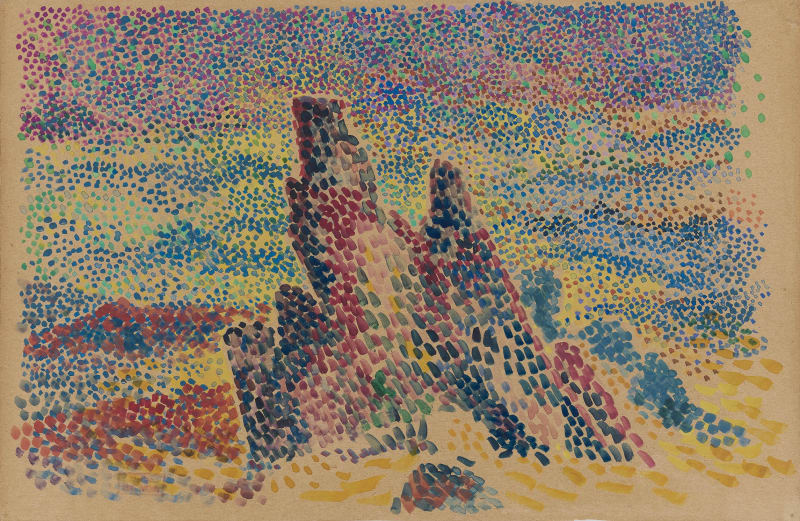Hippolyte Petitjean French, 1854-1929
Hippolyte Petitjean, a Neo-Impressionist, Pointillist painter, began his artistic training in Mâcon at the age of thirteen. In 1872, a bursary enabled him to study at the École des Beaux-Arts in Paris under Alexandre Cabanel (1823-89). Petitjean made his début at the Paris Salon in 1880 and continued to contribute regularly until 1891. The paintings he produced throughout this period reflect the high regard he held for the work of Pierre Puvis de Chavannes (1824-98).
Petitjean was artistically inspired by his close friendship with the artist Georges Seurat (1859-91), whom he first met in 1884. By this time, Seurat had endeavoured to study theories of perception and colour. During which, he laid the foundations for the development of Divisionism, a satellite group affiliated with Neo-Impressionism. Often called Pointillism – though Seurat himself rejected the term – the style drew on colour theories proposed by Michel-Eugène Chevreul. Chevreul's scientific research into optics and colour theories had been published in his book : De la Loi du contraste simultané des Couleurs [On the law of the simultaneous contrast of colours] (1839). Petitjean became an enthusiastic advocate of Divisionism and adopted the technique in 1886. Only a year later, the artist was to show his first large-format Neo-Impressionist painting at an exhibition in Stockholm.
He exhibited regularly at the Salon des Indépendants, from 1891 onwards, as did his friends and fellow practitioners Seurat, Maximilien Luce, Camille Pissarro and Pissarro's son Lucien. In 1892, Petitjean also exhibited work at Le Barc de Boutteville, a gallery pioneering and promoting avant-garde painting.
Further exhibitions followed: in Brussels (between 1893-8), Berlin (1898), Weimar (1903) and Wiesbaden (1921). Despite these exhibitions, Petitjean struggled to earn a living for much of his career, unlike many of his colleagues. After the birth of his daughter in 1895, he moved to a house, with a studio, in the southern part of Paris and began to work as an art teacher. He turned increasingly to allegorical subjects, though a series of decorative landscape watercolours produced in the years 1910-1912, marked his return to Neo-Impressionism. This is typical of the career long inclinations Petitjean acted upon, in oscillating between Neo-Impressionism and more academic work influenced by Puvis de Chavannes. His reconcilation of modern and traditional painting can be seen via his considered and carefully rendered landscapes, whereby his subjects do not rely on allegorical or mythological allusion.
Petitjean’s palette was remarkable for its colouristic vibrancy; he applied dabs of paint with rapid, small brushstokes. Though loose, allowing the paper to show through, this network of tiny, tightly juxtaposed dabs of colour gave the effect of layering. The illusion of alternating tints heightens the colouristic richness and brightness of Petitjean’s scenes. The result obtained from this Neo-Impressionist technique, is a unique 'coloured light' which enhances the liveliness of these compositions.
In a 1920 survey for the Société des Artistes Independants, the scholar and critic Gustave Coquiot stated, ‘In the phalanx of Neo-Impressionists, M. Petitjean ranks very high. He is best known for his Bathers, of pure classical style, and for his vividly coloured landscapes.’
The artist’s work is included in numerous museums around the world, such as, at the Metropolitan Museum of Art, New York; Musée Thyssen-Bornemisza, Madrid; National Gallery of Canada, Ontario; Musée d’Orsay, Paris.
-

Salon du Dessin - 2024
20 - 25 Jan 2024Read more -

Rhythm of lines and colours in French Avant-Garde
28 Jun - 26 Jul 2019Stoppenbach & Delestre is pleased to present 'Rhythm of lines and colours in French Avant-Garde', an exhibition including works by Charles-François Daubigny, Eugène Boudin, Armand Guillaumin, Hippolyte Petitjean, Louis Valtat,...Read more



